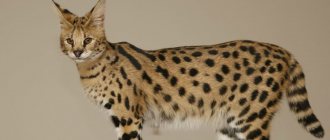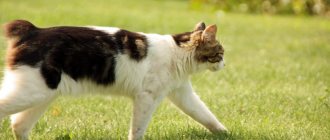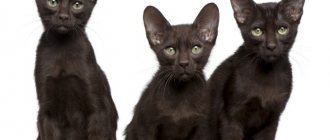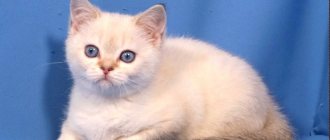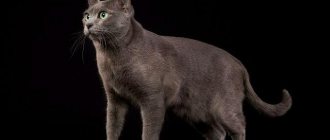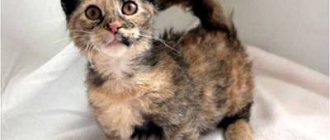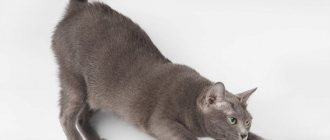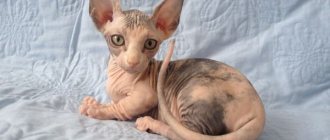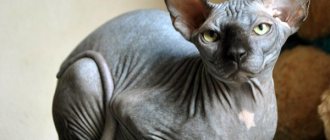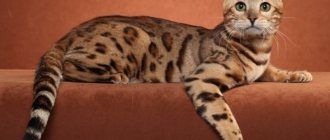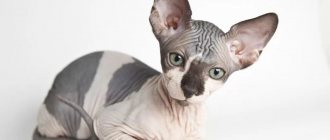| Country of origin | Thailand, UK |
| Dimensions and weight | 4-6.5 kg, length - 60 cm |
| Wool | short, there is a semi-long variety |
| Lifespan | 13-16 years old |
Graceful, slender, sophisticated, incredibly flexible - that's all she is - an oriental cat. But the apparent fragility of these animals is combined with excellently developed muscles and a love of movement. Orientals belong to the Siamese-Oriental group of cats. Therefore, representatives of the breed are often called “Asians”, “Orientals”, “Oriental”, “Orik”, “Ori”. There are other names, some of them are already outdated: cat greyhound, shorthaired pointer, oriental shorthair.
History of the breed
The Oriental Shorthair is a cousin of the Siamese cat. More precisely, it is one breed, but with different colors and eye colors. Siamese have a light body, blue eyes, Orientals have a fully colored body and green eyes. There are no more differences, not even in character.
In ancient Thailand, the Oriental cat was one of the varieties of Royal Siamese cats, which were revered in the imperial palace and temples.
Part I
The ancestors of the Siamese and Orientals were brought from Thailand to England at the same time (late 19th century). There is information that at an exhibition in London in 1896, an oriental cat of a solid blue color was presented. But she was disqualified because there was no Siamese color. The popularity of the Siamese with its point coat and blue eyes has eclipsed the Orientals. And in 1923, the British Siamese Cat Club finally excluded solid green-eyed cats from the Siamese class. All activities related to breeding the breed were stopped.
Part II
After World War II, as the Siamese population declined, some breeders returned to breeding colored cats. First, work began on breeding chocolate-colored oriental cats, which were given the name Havana. A number of historians claim that the shade of the wool is comparable to the rich color of a Havana cigar, hence the name. Then they started breeding lilac orientals, with different colors and patterns.
Part III
An equally interesting story began in America. In 1956, the chocolate cat ended up in California (USA), where they almost immediately began to recognize it as a new breed. In 1964, the CFA approved the independent Havana Brown breed, giving it champion status. Therefore, in Europe, Havana Brown is a chestnut color, and in America it is a separate breed. The same story happened with white Asians, who in 1974 received breed status under the name “Foreign White”.
To obtain new colors, breeders infused Asian cats with the blood of American Shorthair, Abyssinians, Burmese, and Russian Blues.
After this, a campaign began to recognize solid Siamese cats as a separate breed. Already in 1977 the standard was approved. This year and the next, the Oriental breed was at the peak of its fame, entering the top ten most popular. The only exception was for cats with bicolor colors. But in 1995, justice triumphed - the color was recognized.
History of the origin of the breed
Interestingly, the first memory of big cats dates back to the 14th century. For a long time they were the exclusive property of Thailand and were not released beyond its borders. Like their closest cousins, the Siamese, Orientals were considered royal sacred pets, who most often lived at temples or in palaces.
The rule of Siam once banned the export of animals outside the country, so the world saw the Oriental cat only at the end of the 19th century. They first appeared in England, and later became known throughout the world.
Breeding of cats occurred through crossing with Siamese and other breeds of short-haired cats. After several years of experimentation, Orientals gained recognition in 1974.
Oriental semi-longhair cats
In the 80s In the 20th century, oriental cats with long hair, called British Angora, were registered in England. The breed was recognized by the largest felinological system - GCCF. In 2003, the name was changed - the British Angora became the Oriental Longhair.
In America, a cat with silky long hair, a feathered tail and a small beard was the result of crossing a shorthaired Oriental and a Balinese. The kittens received a Balinese build and semi-long hair, but the color remained oriental. In 1997, Oriental Longhair was recognized in the USA.
The Oriental Longhair breed has other names - Oriental Longhair, Mandarin.
Description of the breed
The appearance of the oriental cat provided another interesting name - “greyhound of the cat world.” A beautiful, graceful body, long legs, a whipping tail, an elongated muzzle with expressive eyes and large ears make the image of the Oriental recognizable.
The standard is very similar to the Siamese breed standard. Only in the description of the head and body the word “medium” was replaced with “long”. And also, unlike the Siamese and Thai cats, the fur of Orientals does not change tone due to climatic conditions and hormonal changes.
The Oriental breed is a medium-sized cat. As with other breeds, males are much larger than females. So, the average weight of a male is 4.5-6 kg, a female weighs 3-3.7 kg. Body length without tail is on average 60 cm, height – up to 35 cm.
The standards of the leading felinological systems differ little from each other when assessing the Oriental breed.
Breed standard:
| Become | Description |
| Head | The skull is a well-defined wedge. The nose is straight and long. There is no transition from nose to forehead. The chin is strong, strong, but not massive. The neck is long and slender. |
| Ears | Wide at the base, tapering towards the tip. Set low and wide. The size is very large. The tips of the ears should not droop. |
| Eyes | They are shaped like almonds. The color is rich green without inclusions. An exception is for white orientals, in which blue or different colors are acceptable. |
| Body | Elongated, toned, with well-developed muscles. Shoulders are no wider than hips. |
| Legs | Slender, long, with developed muscles. The hind legs are longer than the front ones. Thanks to this, Orientals are distinguished by their jumping ability. Small, oval paws. |
| Tail | Thin, sharp at the tip, without creases or knots. The length is in harmony with the body, reaching the shoulder blades or a little further. |
| Wool | Very short, silky (with a satin effect), close to the body. There is no undercoat. The Oriental Longhair cat has flowing, fine fur. Because the hairs fit tightly to the body, the fur appears shorter than it actually is. |
External features of an oriental cat
Oriental cats are primarily distinguished by their graceful appearance. Despite some similarities with Siamese, these cats are distinguished by their own characteristics, knowing about which you will definitely not confuse oriental purrs with other breeds.
| Breed name | Oriental cat (oriental) |
| Time of origin | 1974 |
| Country of origin | Thailand |
| Lifespan | 18-20 years old |
| Average weight | 4-7 kg (as an adult) |
| Average height | 25-32 cm |
| Cost of kittens | 200-450 dollars |
Wool
This breed of cats comes in two categories: short-haired and long-haired. The main feature of the animal's fur is its stunning shine. The villi lie tightly to the body and have no undercoat underneath. The hair on the tail is shorter.
Color
Oriental cats can have a wide variety of colors. It’s hard to believe, but today there are more than 300 types of different colors of the animal’s fur coat. This is what caused the Oriental cat to be called one of the most variable breeds in color.
Moreover, the color can be either monochromatic or in various combinations. The most popular colors are: chocolate, lavender, blue, cinnamon, fawn, red.
Head
It is distinguished by a wedge-shaped shape and straight lines. Forms a triangle towards the bottom. The nose is straight and long, cheekbones are pronounced, the forehead is flat, and the chin is narrowed.
Ears
This cat breed is distinguished by its large ears. They are set widely spaced from each other, slightly rounded. The line of the ears continues the line of the animal's head.
Like many representatives of oriental breeds, Orientals are distinguished by early ear growth. Thus, large ears are already observed in a three-month-old kitten, as a result of which it looks a little like the cartoon Cheburashka. With age, the head enlarges and the size of the ears looks more proportionate.
Eyes
Slightly slanting, distinguished by an almond-shaped shape. All but white colors have green eyes. Snow-white Orientals have blue eyes.
Tail
Long, quite thin with shorter hair on it. True, the long-haired Oriental breed has longer, flowing fibers on its tail. Slightly tapering towards the tip.
Body
Oriental cats have a long and slender body with strong muscles. The body itself is elongated, the chest is strong.
The animal's limbs are slender, but at the same time very strong. The hind limbs are longer than the forelimbs. The paws of Orientals are neat and have a rounded shape.
Rainbow colors
Representatives of the Oriental breed have more than 300 color varieties. For such abundance, the Oriental Shorthair received the nickname “rainbow cat.”
With all the variety of colors, patterns and types, the color of the eyes is exclusively green.
Solid colors
- Ebony (ebony). One of the most beautiful, making the cat look like a black panther. The fur is completely jet black from tip to root, without a hint of rusty hairs. The same black paw pads and tip of the nose.
- Chestnut (chocolate, Havana). Uniform, warm chestnut brown color. An animal with a Havana coloration looks very exotic.
- Lavender (lilac). The fur is pink-gray, as if covered with frost. But the color should not be too blue or fawn. The nose and paw pads are pinkish-lilac.
- Blue. The coat is uniformly blue, without a hint of silver or rust. The paw pads and nose are the same.
- Red. Monochromatic, no patterns or shades.
- Cream. Pure color preferably light tones.
- Tortoiseshell. There are spots scattered all over the cat's body. This happens if the main coat color is diluted by a red or cream color.
- Faun. Light beige color, which is called the “color of a young fawn.”
- Cinnamon (cinnamon color). All chocolate brown tones: brown, sandy brown (not red) with copper or bronze undertones. Markings may be visible on light coats - this is acceptable, but preference is given to a richer, purer color.
- Smoky. A variation when, with the main or tortoiseshell color, the lower part of the hairs remains white due to the lack of pigment.
- White. Pure white color without a hint of yellowness. The eyes of such cats can be blue, green, or one blue, the other green.
Tabby colors
Patterned colors such as brindle, harlequin, ticked, and spotted are common. All varieties are characterized by the letter M on the forehead, lines from the outer corners of the eyes to the back of the head, several necklaces on the neck, 2 rows of dots running along the chest and stomach. Rings cover the legs and tail.
Varieties of patterned colors:
- Brindle. A narrow continuous line runs from the back of the head to the tail. The entire body is covered with stripes running from the spine to the lower abdomen.
- Spotted. It is similar to a brindle, but the longitudinal and transverse stripes are divided into spots of different shapes - round, oval.
- Marble. Lines run from the head to the shoulders, forming a butterfly-shaped pattern. Three parallel lines can be traced along the back from the “butterfly” to the base of the tail. On each side there are spots symmetrically located, surrounded by one or more rings.
- Ticked. There is no pattern on the body, but each hair consists of alternating areas of dark and light color.
Coat colors of oriental cats
To obtain numerous colors, breeders bred representatives of the Oriental breed with Abyssinian and Russian blue cats. And to get a black oriental, we had to use simple outbred black cats.
Orientals are similar to their close relatives – Siamese cats. But the latter only have blue eyes, while Oriental cats have golden-green irises.
Brown and black cats predominate, and there are few white Orientals. The table shows the possible colors of oriental pets according to the breed standard.
| Oriental color | Description | Nose color | Paw pad color |
| cinnamon | light brown | light pink | light brownish pink |
| Havana | this is the name of the oriental chocolate color, each hair is evenly colored in a soft and rich brown, almost black color | brown | pinkish brown |
| blue | ashy with a bluish tint | bluish gray | grey |
| faun | beige with evenly colored hairs | light pink | light beige pink |
| red | rich and uniform red | light pink | pink |
| lilac | silver-gray with a cool lilac tint | pale and dull pink | grayish pink |
| black | deep and uniform black color without a single light spot | black | black |
| white | pure and uniform color without yellowness | pale pink | pink |
| tortoiseshell | tricolor, spotted, with obligatory inclusion of red and black colors | determined by the predominant color | |
| tabby brindle | a pattern of thin vertical lines running from the ridge to the belly | determined by the predominant color | |
| marbled tabby | a pattern of clear spots of different sizes and shapes, reminiscent of the surface of marble | determined by the predominant color | |
| tabby spotted | pattern of round, oval or rosette spots | determined by the predominant color | |
| tabby ticked | Each hair has a heterogeneous color, divided transversely into a basic light color and a contrasting black color. | determined by the main color | |
Possible defects of the breed Oriental cats with the following defects are not allowed to participate in exhibitions:
- squint;
- polydactyly (six-fingered);
- any color of the iris except green;
- deformed chest, protruding keel;
- thin physique, undeveloped skeleton;
- underweight;
- broken tail;
- weak limbs;
- not nasal, but pathological mouth breathing;
- reddish tint of black wool, yellowish tint of white;
- developed, voluminous undercoat.
Character of an oriental cat
All oriental cats have a unique character. Orientals are no exception. Developed intelligence, intelligence, quick wit, affection for the owner, playfulness, talkativeness and eternal busyness - these are the main characteristics of the breed. And the behavior is called nothing less than “dog-like.”
Orientals are one of the most talkative cats. These are very emotional animals. They are not shy about purring, purring loudly just to express their feelings. But not idle. If a cat purrs, it means he needs to speak out: perhaps something hurts, or he is scared or, conversely, happy. Any action does not take place silently, but is accompanied by “conversation.” He will not shake the air while no one is home. He needs a person to communicate.
It is not known what Orientals love more - chatting or being close to the owner. Ori are loving, and become so attached to their owner that they can become depressed if he is absent for a long time. This breed is recommended for people who spend most of their time at home. Either take 2 cats into the house at once or get some other pet. Orientals are friends with everyone. They get along well with children and enjoy playing with them. Get along well with other animals. The adjustment period takes very little time. They find a common language quite quickly even with a dog. Only first they will try to take the position of leader. If the dog does not agree, conflict cannot be avoided. Here the owner’s task is to help make friends between the cat and the dog.
Care and maintenance
Oriental cats do not require any special care. However, it is up to the owner to ensure that the pet lives longer, is healthy and happy.
The Oriental needs daily exercise and play that stimulates its natural instincts to hunt and explore. Therefore, it is better to keep your cat's body and mind active, otherwise behavior problems may develop.
In addition, due to their activity, Orientals are the cats that fall out of windows more often than others. Therefore, when keeping an apartment above the 2nd floor, nets on the windows and a glazed balcony are required.
Grooming
The lack of undercoat and short hairs do not cause trouble to the owner. Of course, Orientals also shed. But it is enough to comb them periodically with a rubber brush or a special glove. There is practically no wool on clothes or furniture. Mostly it accumulates in the resting place.
Tangerines have a small undercoat, which gives them more wool. Brush the animal 1-2 times a week, every day during shedding.
Water treatments
Orientals are bathed only when they are heavily soiled, for example, by accident, or before an exhibition. Most cats do not like to bathe, and the Oriental is no exception. It is important after washing to prevent the animal from getting into a draft.
Nail care
Claw trimming is carried out every 2 weeks. But these terms are arbitrary; some pets will need to do this every 10 days, others – once a month. The procedure is carried out with a special tool (nail clipper) so as not to damage the claws.
Care for ears, eyes, teeth
An obligatory part of care is cleaning the ears, eyes and teeth. They are accustomed to the procedure from infancy, otherwise the cat will resist.
Wipe the ears and eyes with a cotton pad soaked in warm boiled water or a special lotion.
Cats don't take very good care of their teeth. Without additional help from the owner, there is a risk of dental disease. Typically, it all starts with plaque, which should be combated by regular brushing.
Deworming
Prevention of worms is a mandatory procedure. It is carried out 10 days before vaccinations and preferably every six months. There are a lot of deworming drugs. The dosage of almost all is selected by weight. Veterinarians recommend choosing complex medications that act on different types of worms.
Toilet issue
All kittens in the nursery are already litter box trained. And at first it is better to use the same type of tray that the breeder had. This way the kitten will adapt faster and learn to go to the right place.
Orientals love to dig. Therefore, it is better to choose a tray with high sides or a toilet-house. Any filler your pet likes.
How long do oriental cats live?
Oriental cats have a fairly typical lifespan for felines - an average of 5 years, but there are also centenarians. With proper care, nutrition, and the absence of genetic diseases, the Oriental, without losing its playfulness, can live up to 20 years.
Is the Oriental cat hypoallergenic?
The Oriental Shorthair has short hair, so it does not shed as much as other breeds. Researchers also believe that Orientals produce less protein, which is the main allergen. These 2 facts became the basis for including the Oriental cat in the list of hypoallergenic breeds. However, no breed is 100% allergen-free.
Maintenance, care, nutrition, health
The life expectancy of an Oriental is from 15 to 20 years, subject to proper care. Moreover, care and attention are only part of what a pet will need.
You need to be prepared to arrange a place to sleep and a toilet, ideally a cat house with shelves, scratching posts, toys and other little things.
Complete cat care includes the following:
- Wipe your eyes daily to remove any discharge. To do this, use a cotton swab or soft natural material, pre-moistened in purified water or tea leaves.
- Cleaning the ears 1-2 times a week with cotton swabs, Vaseline or oil. In this case, you should be careful with fragile cartilages and do not press on them.
- Brushing the fur with a rubber glove should be done no more than once a week, moving from head to tail. If you rub a piece of suede or velvet fabric after the procedure, you can increase the shine of the coat.
- You should not bathe him, except with rare exceptions, if the pet is heavily soiled and cannot cope with cleaning on its own. Otherwise, the Oriental is very clean and is able to cope with cleaning the fur on its own.
- Cleaning your teeth from tartar and plaque should be done regularly. To do this, you can give your kitten special treats and visit the veterinarian every month to avoid gingivitis and gum inflammation.
- Their claws grow very quickly and need monthly trimming. In this case, the nail clipper is used to trim no more than 2 mm at a time. It is better to accustom them to this from the first months, cutting one claw per week.
- Short-haired cats need constant warmth as they often get cold. Therefore, in the rooms where they are kept, it is worth avoiding drafts and maintaining a microclimate.
- The cat should be fed 2-3 times a day using dry food, canned food or natural food. At the same time, completely eliminate spicy and salty foods, and warm the food to room temperature. The daily diet is 250-300 kcal.
- Preventive measures to combat worms and fleas. Monitoring the pet's condition for a timely response to the disease. Thus, they are prone to diseases of the respiratory tract and cardiovascular system, liver and kidneys, and skin.
Feeding
Orientals value a fit and muscular body, so they should not be overfed. But representatives of the breed are big food lovers. They will constantly demand food. If the owner refuses for some reason, then theft has not yet been abolished. They will find it, steal it, eat it. Therefore, you cannot follow the lead. One or two “begged” treats and the oriental will already “twist the ropes” out of the owner, and begging for a tidbit will become a habit. However, excess weight in cats not only spoils their appearance, but also causes health problems.
Health
Shorthaired Orientals and Mandarins have excellent health and strong immunity. But there is still a predisposition to certain diseases:
- Gingivitis is an inflammation of the gums that, without timely treatment, develops into periodontal disease.
- Cardiomyopathy is a heart disease in which the walls of the ventricle harden. The volume of the heart chambers decreases, which leads to the development of heart failure.
- Retinal atrophy is a hereditary defect in which the visual cells of the retina are destroyed, which leads to partial or complete blindness. The disease occurs both at a young age (3-4 months) and at a later age (after 4-5 years).
- Flat chest syndrome is a hereditary pathology. The chest becomes flat or funnel-shaped. The problem is identified immediately after the kitten is born.
Pros and cons of the breed
According to reviews from owners, the Oriental breed has many advantages, but there are also disadvantages, if you can call them that.
Good companion
Gets along well with children and other animals
Loving, affectionate, gentle
Easy to learn and trainable
Very talkative, she will definitely insert her meow on every occasion
Can be annoying, as it follows the owner's heels
Unable to remain alone for long periods of time
What to feed an Oriental cat?
Oriental breed kittens are not picky about food, which is why they are prone to obesity. Therefore, it is better to use premium and super-premium dietary dry food for their nutrition. If you want to feed your cat natural products, include in his diet:
- lean meats;
- lean sea fish fillet;
- porridge (with water or milk);
- boiled eggs;
- vegetables (carrots, green beans);
- dairy products.
If you feed your Oriental kitten natural food, add a vitamin and mineral complex to the diet.
How to choose a kitten
When choosing and purchasing a purebred Oriental kitten, it is important to know:
- The breeder will not give away the kitten until it is 3 months old. If they sell smaller kittens, this is a reason to think about it.
- Each purebred kitten must have a birth certificate (birth certificate) or pedigree if it is a show kitten. A pet without documents is not a real Oriental.
If you have doubts whether the litter has been registered, you can always check with the club in which the nursery is listed.
At the age of 2 months, the litter is assessed (actuation). Kittens are divided into 2 categories: those who participate in further breeding and those who do not. The cost of the kitten depends on this. On average, it starts from 20 thousand rubles.
There are too many factors that influence the price. The main one is the type of kitten. The extreme type is valued higher - eared, with a long muzzle, thin bones, and very short hair. All breeders strive to get just such kittens. The price for them starts from 40 thousand rubles. Of course, the cost is determined by color, quality (the presence of defects reduces the cost), and the purpose of purchase (for breeding or castration). Therefore, the price for a kitten as a pet can be 100 thousand rubles, and with the right of breeding 120 thousand and more.
